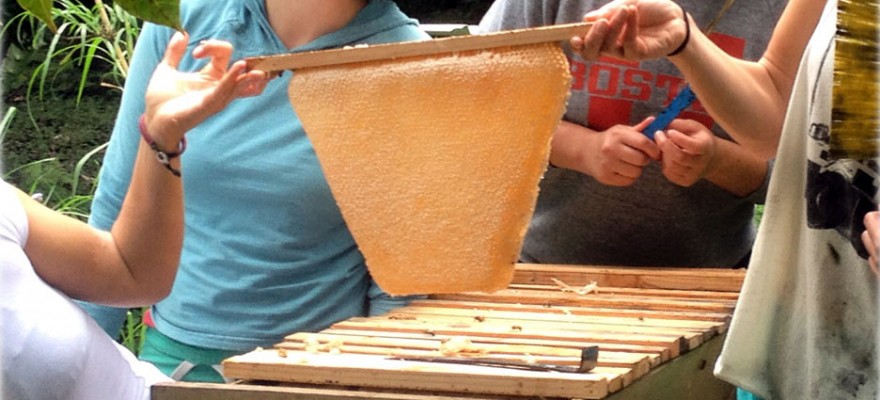
What a straight honey comb should look like
Crisscrossed combs in a top bar hive can lead to a lot of frustration for the beekeeper. These misshapen combs often take up more than one bar and make it difficult if not impossible to navigate through a hive quickly. If you’re looking for eggs, the queen, or simply trying to harvest honey; keeping combs straight is beneficial to a hive. Here are a few tips to help the beekeeper keep a neat and orderly hive.
The first rule of thumb is that straight combs, follow straight combs. If your last comb in the hive is not straight, you can bet the next comb the bees will build will follow suit. The bees will build straight from straight just as sure as they will build crooked from crooked. Make sure you put your straightest comb at the ends of the hive body.

Add empty bar in between two straight combs
Secondly, if some of your combs are straight and some janky, put blank bars in between straight combs. By placing an empty bar right in the middle of two straight combs, you will get the bees to build another straight comb. This is a good way to improve your hive and produce more straight combs. The key is to produce more straight combs than crooked, eventually removing the crooked.
Incidentally, by placing a blank bar in between straight combs in the brood chamber you will encourage the bees to build straight comb where the queen will lay eggs. In a weeks time, you will have a small, comb filled with eggs. This is an easy way to make sure you have eggs when doing a split*.
If you find crossed comb, taking up many bars, make sure you mark the bars so that you will know which combs need to be removed together and not individually. I use the sharp end of my hive tool and place a horizontal line over the two or three crossed hive bars. There is nothing more terrifying to a beekeeper than to inadvertently break comb and have it fall to the bottom of the hive. If the dropped comb contains brood, I usually prop it up on one of the ends of the hive box and check it weekly. Once the brood hatches the bees will quickly fill it with nectar so remove it as soon as the brood is gone.

Eggs on newly built comb
Next, one of the best times to harvest honey, is after the hive has swarmed. In Hawaii, I can harvest honey two or three times a year from a top bar hive. There will be less bees and it is the opportune time to remove old crossed comb. Do not remove crossed comb if eggs, or brood is still present. Check the hive weekly for hatched brood and nectar filling.
When a hive prepares to swarm, the bees will start filling up comb with nectar to discourage the queen from laying. The queen will have laid drones (male bees) which are the bullet shaped capped brood. The bees will begin to produce a new queen by building swarm or queen cups. When they swarm, typically, the old queen goes with the swarm and the unhatched queens stay. Hives often build more than one queen at this time to make sure of at least one laying queen. The surviving maiden queen will go on her maiden voyage to mate before she can start laying eggs. The time to clean out old and crisscrossed comb is before the new queen starts to lay. Check your hive weekly for the right conditions for removal.

Janky honey comb at the end of the hive box
Lastly, the bees often will build crazy combs at the end of the hive body. Usually, these combs are strictly for storing nectar and honey. If you check your hives often enough, you will know how close the hive is to capping the nectar. The bees will cap nectar after it has turned into honey. A beekeeper will only want to harvest a hive when she believes all honey comb is capped.
I always keep two buckets when I do a harvest, one for nectar and one for honey (sometimes combs contain both). You will need to use your hive tool to separate the nectar from the honey and put them in the appropriate bucket. When nectar and honey are mixed, you can get crystalized or granular honey instead of the thick, free-lowing honey.
Don’t worry too much if the combs are janky at the end of the hive where the bees are strictly storing honey. You can pull off the bar from the comb on the first two or three if they are not coming out. It’s a bit of a job removing the capped honey comb but as long as you get it out without killing bees or loosing too much honey. After you remove the end combs, if you’ve done your job correctly, the rest of the honey comb will come out nice and easily.
Well, there you have it, some good tips on keeping the combs in a top bar hive straight. I hope you are encouraged to try a few of these tips to practice healthy beekeeping for you and the bees.
*Two of the easiest ways to start a new hive is by catching a swarm and by splitting a hive. When a beekeeper splits a hive, she removes at least three combs filled with honey, brood, eggs, bee bread and plenty bees. She places them in an empty bee box. The bees will soon build a new queen from the eggs.
